Content from the Brookings Doha Center is now archived. In September 2021, after 14 years of impactful partnership, Brookings and the Brookings Doha Center announced that they were ending their affiliation. The Brookings Doha Center is now the Middle East Council on Global Affairs, a separate public policy institution based in Qatar.
Oman’s Sultan Qaboos bin Said Al Said died at age 79 on January 10. The sultan, who ruled Oman since he deposed his father with British support in 1970, had no children or siblings, and therefore no heir apparent. The absence of a clear line of succession has long worried Omanis and allies as Qaboos’ health deteriorated over the last decade.
However, the succession took place smoothly, with the Royal Family Council appointing Qaboos’ cousin — Haitham bin Tariq Al Said — within 24 hours of Qaboos’ death, on the late sultan’s recommendation. Haitham bin Tariq, 65, was the minister of heritage and culture from 2002 until his ascension to the throne. Under Qaboos, he had also served as secretary general for the Ministry of Foreign Affairs (1994-2002) and as undersecretary for the Ministry of Foreign Affairs in political affairs (1986-1994).
Qaboos’ illness and death shook Omanis: He was modern Oman’s founding father and held an overpowering role in Omani domestic and foreign affairs. He headed the state, government, and military, and directed a foreign policy focused on deft diplomacy in a fraught region.
Notwithstanding his robust rule, Oman under Qaboos was plagued with economic hardship and a closed political scene that led to various episodes of dissidence. The economy’s limitations and the expectations of a changing population will likely cause protests to multiply in the near future. The new sultan must therefore focus on job creation, diversifying Oman’s economy away from natural resources, and introducing controlled political reforms.
Building modern Oman
Qaboos deposed his father Said bin Taimur on July 23, 1970. He took over an impoverished country with a weak state and a Britain-focused isolationist foreign policy, lacking in infrastructure, hospitals, and schools. Significant evidence shows that the British had engineered the coup because of massive opposition to Said’s rule and his reticence to modernize Oman. By that point, Said — who had contained important tribal dissidence during the Jabal Akhdar wars — was facing a region-wide rebellion in Dhofar and feared that modernizing the country would incite further dissidence. By contrast, Qaboos, who was educated in Sandhurst in the United Kingdom and who had been placed under house arrest in Salalah on Said’s orders, presented a safe choice as a sultan who would likely embrace modernization.
Using rents from natural resources (petroleum, natural gas, and minerals) wisely, Qaboos modernized and transformed Oman, developing its infrastructure, healthcare, and educational systems, as well as various income-generating sectors (including tourism, fisheries, and agriculture). In an attempt to decrease Oman’s dependence on oil, he focused on income diversification, industrialization, developing natural gas production, and privatization. Under his orders, a project to Omanize the public and private labor force was launched to address high unemployment rates.
In terms of politics, the new sultan created an entire government with new ministries, assigning senior positions to members of the royal family while ensuring that the latter retained a relatively limited role in government compared to other Gulf ruling families. Qaboos went on to assert his authority and consolidate his powers. At the end of 1972, he took on the roles of prime minister, supreme commander of the armed forces, as well as ministers of interior, defense, and finance. In 1981, he founded the Consultative Assembly, a bicameral representative body which in 2003 became elected through universal instead of limited suffrage. In 1996, Qaboos introduced Oman’s de facto constitution, the Basic Law. This was followed by the creation in 1997 of the Council of State, whose members were all appointed by the sultan, to assist the sultan in implementing his development, economic, and cultural strategies.
Under Qaboos, Oman’s infrastructure and landscape transformed and flourished. Qaboos built international airports, upgraded and added to the roads and port networks, and erected new buildings for offices and stores; importantly, he did not neglect the Imamate region in the interior, nor Dhofar in the south, in favor of the coastal region as his predecessor had done. He also created schools and universities, built art centers and an opera, and invested in Oman’s healthcare system and social services. Qaboos also spent to improve an already adequate military, which provided jobs for Omanis.
Finally, the late sultan abandoned his predecessor’s isolationism and opened Oman to the rest of the world, adopting a neutral foreign policy that transformed Oman into a key regional player. He strengthened the country’s ties to the other Gulf monarchies, which formed the Gulf Cooperation Council in 1981. Oman maintained relations with Qatar and Iran, despite Saudi and Emirati pressures after a spat in 2016. Qaboos even acted as a mediator between Iran and the United States in the 2013 negotiations over what became the Joint Comprehensive Plan of Action, or Iran nuclear deal. In 2018, he met with Israel’s prime minister and remains the only Gulf leader to have done so publicly.
Triggers of dissent: A struggling economy
Although some sources portray Oman as having experienced little or no political instability, there has been political unrest in the sultanate in the form of rebellions, protests, and strikes. Earlier in Oman’s modern history — during Said’s reign and at the beginning of Qaboos’ — opposition movements were secessionist or sought to overthrow the regime altogether. More recently, dissidence was mostly motivated by a desire for political and socioeconomic reform.
Since deposing his father, Qaboos successfully contained a series of strikes in 1970 (in Nizwa, Rustaq, Ibri, and in the Fahud oil field), a violent uprising in Matra in 1971, and the second half of the Dhofar Rebellion (1970-75). The authorities also reportedly foiled two Islamist plots in 1994 and 2005 before they unfolded, according to official sources. Economic hardship has been an important trigger of dissent in the last decade, including during the 2011 uprisings, the 2012-13 post-Arab Spring protests, and unemployment protests in 2017-18.
Indeed, unemployment is an important issue for the sultanate, where 16.9% of nationals were unemployed in 2017 — and over 30% for young people. Furthermore, because oil exports have been the leading revenue generator in Oman since 1967 (see Figure 1) the rise and fall of oil prices impacts the economy. The latter suffered in recent years due to the global collapse in oil prices (which crashed to $47.11 per barrel in December 2014, then to $45.69 in August 2015, and finally to $29.70 in January 2016). Because of Oman’s comparatively smaller reserves (see Figure 2), this resulted in a decrease in its GDP growth from 4.98% in 2016 to 0.267% in 2017. The regime attempted to address this issue by cutting public spending (by raising taxes and reforming the subsidy system) but reined back its efforts after they triggered protests in 2017-18.
Figure 1: Oman: Revenue minus production cost of oil, % of GDP
 Source: Author’s calculations, using data from the World Data Bank.
Source: Author’s calculations, using data from the World Data Bank.
Figure 2: MENA region proven oil reserves, 2017
 Source: Author’s figure using data from the World Data Bank
Source: Author’s figure using data from the World Data Bank
Outlook: A new sultan’s first steps
The country’s economic struggles and its closed political sphere have led to multiple opposition events in the past and will likely lead to further protests under Haitham bin Tariq. To minimize dissidence, the new sultan must focus on bolstering the country’s struggling economy and adapting its political scene to better suit a changing population.
Currently, Oman’s economy is stable but low-performing; the first step to strengthening it will be designing a plan to diversify it away from natural resources. Falling oil prices and the fact that Oman’s oil reserves have proven to be lower than initially believed makes Oman vulnerable. At a recovery rate of 700,000 barrel per day, Omani oil reserves will likely be depleted within 20 years (this is based on a calculation using data from Petroleum Development Oman, which lists current oil reserves in the country at 5.373 billion barrels). More oil may be discovered in Oman, but this will not affect this estimated timeframe of reserve depletion unless it is discovered in great quantities. What does this mean for the regime? It will have to adapt to a post-oil economy sooner than other GCC states with higher reserves, such as Qatar and the United Arab Emirates.
The regime has already taken steps towards diversification by strengthening non-oil sectors; these steps have led to slightly less reliance on oil (see Figure 3), but this is not enough. The tourism sector, for example, accounted for 2.59% of GDP in 2018. The regime can raise this number by facilitating the visa requirements for more nationalities, which would increase the number of visitors. The regime must also focus on fostering greater employment opportunities for Omanis. Creating more jobs and pursuing Omanization alone will not be sufficient. Rather, the regime must specifically train Omani nationals in skillsets in non-oil sectors.
Figure 3: Oman’s GDP, according to type of economic activity (%)
 Source: Author’s graph using data from the World Bank.
Source: Author’s graph using data from the World Bank.
On the political front, the regime will have to adapt its behavior to catch up with the transformations its population is undergoing. Small civil society pockets are developing, and young, educated people are disillusioned with the regime’s obvious reluctance to carry through the reforms promised in the past. As a first step, the regime must change the way it uses repression. The Omani regime has intensified its efforts to suppress free speech since 2012, arresting activists and passing laws that make political critique illegal. Yet, brash and overt authoritarianism is less acceptable in the Omani context of the 21st century, as can be seen through online petitions, increased participation in the 2011 elections, and the disdain towards the regime’s repressive behavior in the 2012-15 protests.
The Brookings Institution is committed to quality, independence, and impact.
We are supported by a diverse array of funders. In line with our values and policies, each Brookings publication represents the sole views of its author(s).

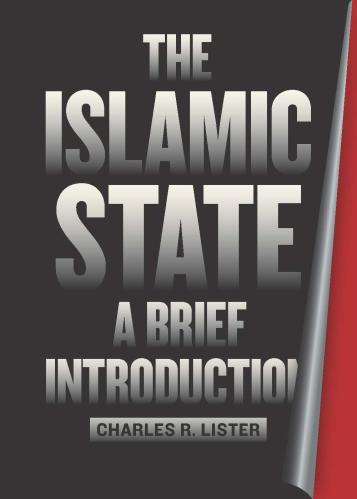
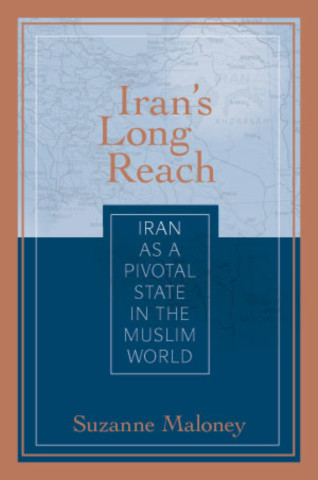
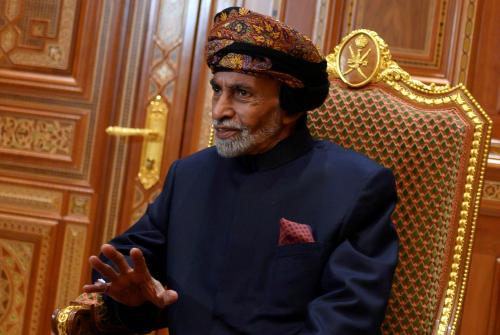

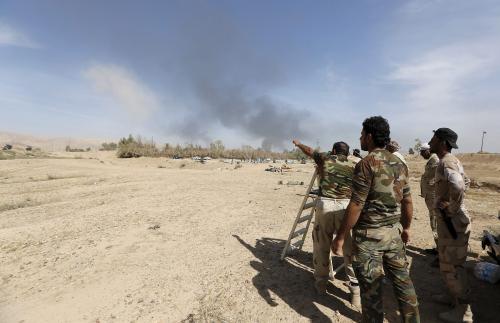
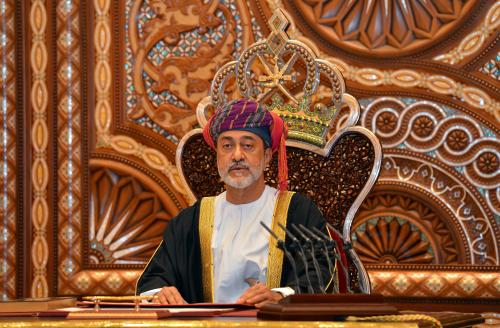
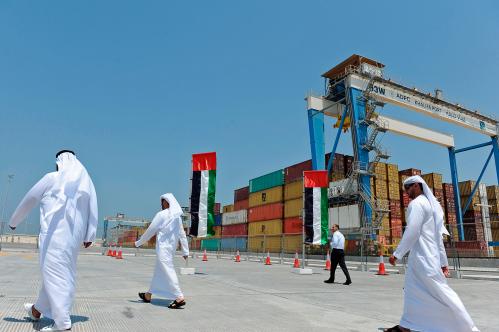
Commentary
As Oman enters a new era, economic and political challenges persist
January 15, 2020